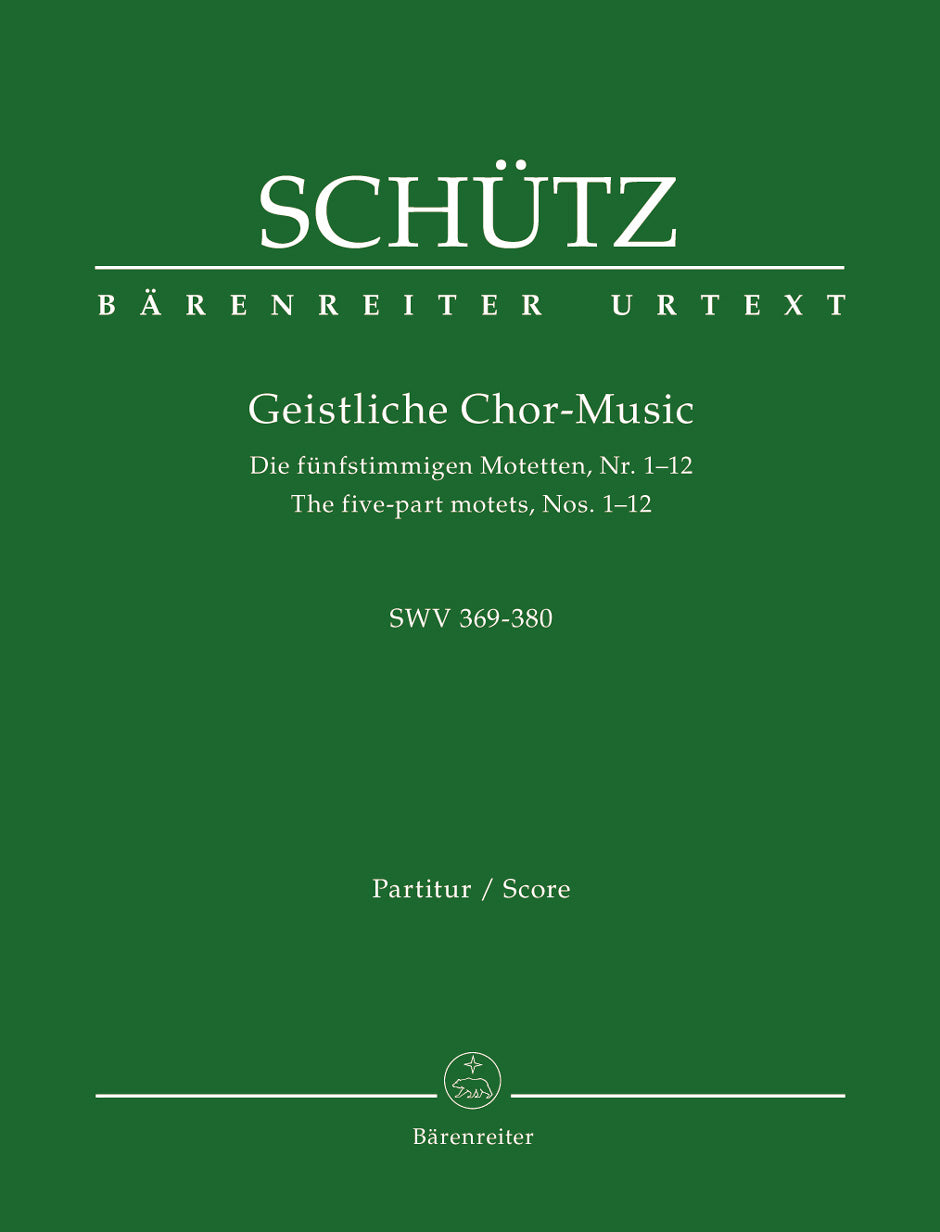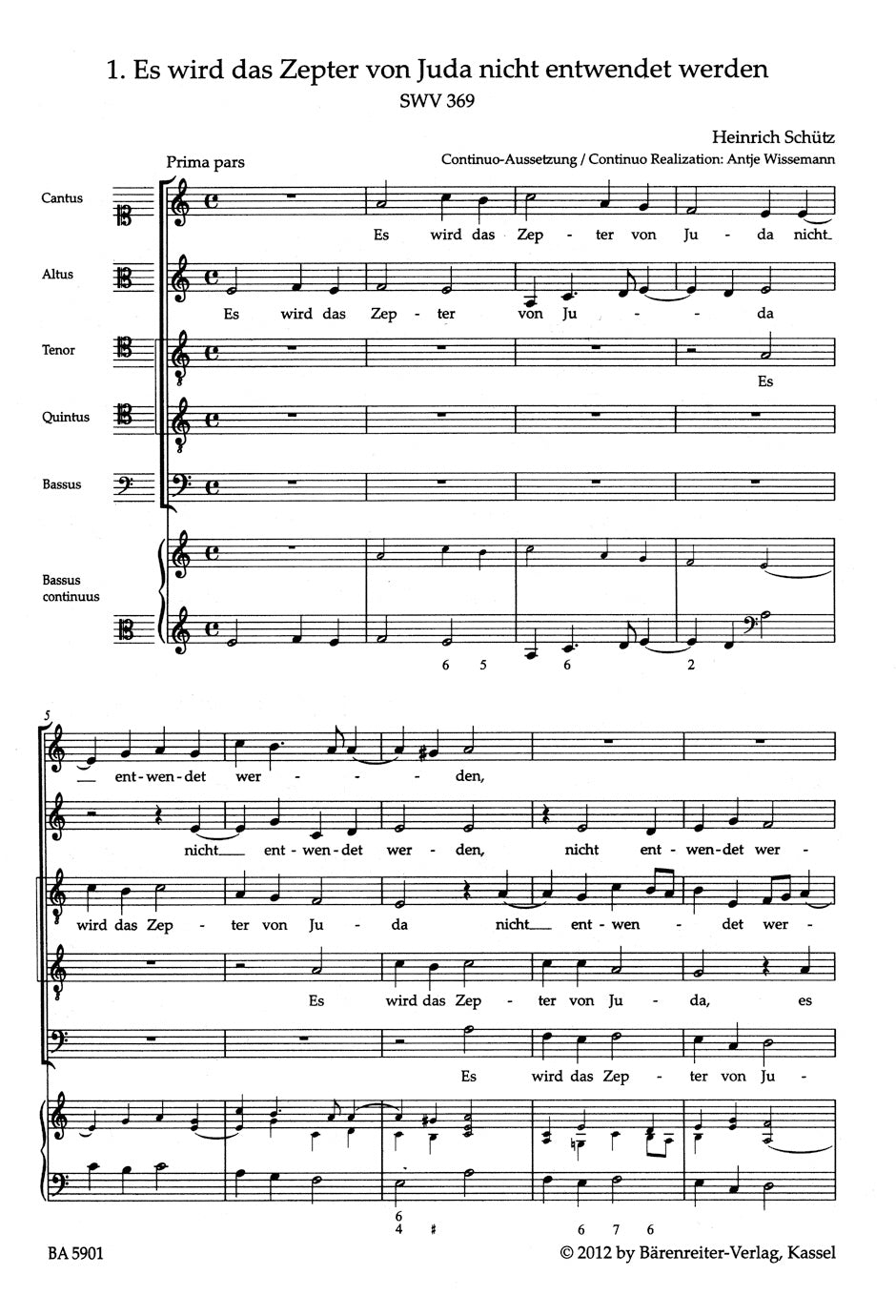Schütz: The 5-Part Motets, Nos. 1-12, SWV 369-380
In stock and typically ships within 1 business day.
- Composer: Heinrich Schütz (1585-1672)
- Editor: Werner Breig
- Instrumentation: Basso continuo, SATB Choir
- Work Language: German
- ISMN:
- Size: 7.5 x 10.6 inches
- Pages: 105
- Urtext / Critical Edition
Description
In 1648 Heinrich Schütz published a collection of 29 motets with five to seven parts titled "Geistliche Chor-Music" (Sacred Choir Music). Here, the term "Chor" (choir) refers not only to a (large) vocal ensemble but, more generally, to a group of musicians, vocal or instrumental. As explained by Schütz in the foreword he published with the collection, all parts of the motets can be performed vocally and/or instrumentally.
This practice, common in Schütz's time, has been incorporated into Bärenreiter's publication. The edition includes the twelve five-part motets at original pitch with basso continuo. in addition, instrumental parts for string and wind instruments can be purchased. These parts, which include the text, serve to support and complement the choral sound "colla parte". To enable varying tone-colour possibilities, instrumental parts are available in different transpositions.
Of great significance is the detailed foreword on performance practice by Manfred Cordes.
Works:
- Es wird das Zepter von Juda nicht entwendet werden. Prima pars (Prima pars), SWV 369
- Er wird sein Kleid in Wein waschen. (Secunda pars), SWV 370
- Es ist erschienen die heilsame Gnade Gottes, SWV 371
- Verleih uns Frieden genädiglich (Prima pars), SWV 372
- Gib unsern Fürsten and aller Obrigkeit (Secunda pars), SWV 373
- Unser keiner lebet ihm selber, SWV 374
- Viel werden kommen von Morgen and von Abend, SWV 375
- Sammlet zuvor das Unkraut, SWV 376
- Herr, auf dich traue ich, SWV 377
- Die mit Tränen säen, werden mit Freuden ernten, SWV 378
- So fahr ich hin zu Jesu Christ, SWV 379
- Also hat Gott die Welt geliebt, SWV 380
Publishers use a lot of words to describe what they sell, and we know it can be confusing. We've tried to be as clear as possible to make sure you get exactly what you are looking for. Below are descriptions of the terms that we use to describe the various formats that music often comes in.
Choral Score
A score for vocalists that only contains the vocal lines. The instrumental parts are not there for reference. Generally, cheaper than a vocal score and requires multiple copies for purchase.
Facsimile
Reproductions of the original hand-written scores from the composer.
Full Score
For ensemble music, this indicates that the edition contains all parts on a single system (there are not separate parts for each player). In larger ensembles, this is for the conductor.
Hardcover
Hardbound. Generally either linen-covered or half-leather.
Orchestral Parts
Similar to a wind set, this is a collection of parts. In the case of strings, the numbers listed are the number of copies included, though generally these are available individually (often with minimum quantities required).
Paperback
When publishers offer multiple bindings (e.g. hardcover) or study scores, this is the "standard" version. If you're planning to play the music, this is probably what you want.
Performance / Playing Score
A score of the music containing all parts on one system, intended for players to share. There are not separate parts for each player.
Set of Parts
For ensemble music, this indicates that there are separate individual parts for each player.
Solo Part with Piano Reduction
For solo pieces with orchestra, this is a version that contains a piano reduction of the orchestra parts. For piano pieces, two copies are typically needed for performance.
Study Score
A small (think choral size) copy of the complete score meant for studying, and not playing. They make great add-ons when learning concertos and small chamber works.
Vocal Score
A score prepared for vocalists that includes the piano/organ part or a reduction of the instrumental parts.
Wind Set
For orchestral music, this is a collection of wind and percussion parts. The specific quantities of each instrument are notated.
With Audio
In addition to the printed music, the edition contains recordings of the pieces. This may be an included CD, or access to files on the internet.
With / Without Fingering (Markings)
Some publishers prepare two copies - a pure Urtext edition that includes no fingering (or bowing) suggestions and a lightly edited version that includes a minimal number of editorial markings.




